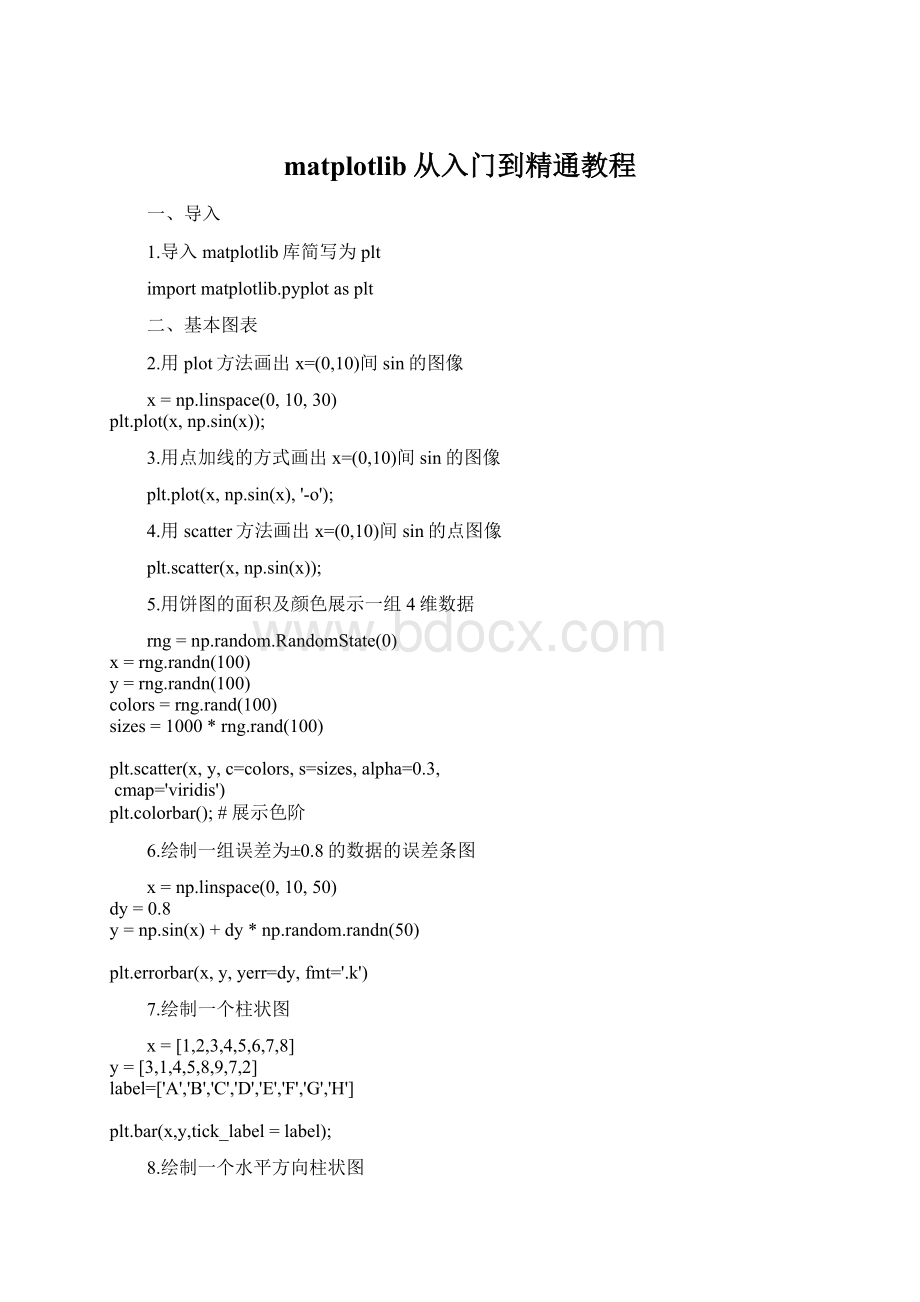matplotlib从入门到精通教程.docx
《matplotlib从入门到精通教程.docx》由会员分享,可在线阅读,更多相关《matplotlib从入门到精通教程.docx(9页珍藏版)》请在冰豆网上搜索。

matplotlib从入门到精通教程
一、导入
1.导入matplotlib库简写为plt
importmatplotlib.pyplotasplt
二、基本图表
2.用plot方法画出x=(0,10)间sin的图像
x=np.linspace(0,10,30)
plt.plot(x,np.sin(x));
3.用点加线的方式画出x=(0,10)间sin的图像
plt.plot(x,np.sin(x),'-o');
4.用scatter方法画出x=(0,10)间sin的点图像
plt.scatter(x,np.sin(x));
5.用饼图的面积及颜色展示一组4维数据
rng=np.random.RandomState(0)
x=rng.randn(100)
y=rng.randn(100)
colors=rng.rand(100)
sizes=1000*rng.rand(100)
plt.scatter(x,y,c=colors,s=sizes,alpha=0.3,
cmap='viridis')
plt.colorbar();#展示色阶
6.绘制一组误差为±0.8的数据的误差条图
x=np.linspace(0,10,50)
dy=0.8
y=np.sin(x)+dy*np.random.randn(50)
plt.errorbar(x,y,yerr=dy,fmt='.k')
7.绘制一个柱状图
x=[1,2,3,4,5,6,7,8]
y=[3,1,4,5,8,9,7,2]
label=['A','B','C','D','E','F','G','H']
plt.bar(x,y,tick_label=label);
8.绘制一个水平方向柱状图
plt.barh(x,y,tick_label=label);
9.绘制1000个随机值的直方图
data=np.random.randn(1000)
plt.hist(data);
10.设置直方图分30个bins,并设置为频率分布
plt.hist(data,bins=30,histtype='stepfilled',density=True)
plt.show();
11.在一张图中绘制3组不同的直方图,并设置透明度
x1=np.random.normal(0,0.8,1000)
x2=np.random.normal(-2,1,1000)
x3=np.random.normal(3,2,1000)
kwargs=dict(alpha=0.3,bins=40,density=True)
plt.hist(x1,**kwargs);
plt.hist(x2,**kwargs);
plt.hist(x3,**kwargs);
12.绘制一张二维直方图
mean=[0,0]
cov=[[1,1],[1,2]]
x,y=np.random.multivariate_normal(mean,cov,10000).T
plt.hist2d(x,y,bins=30);
13.绘制一张设置网格大小为30的六角形直方图
plt.hexbin(x,y,gridsize=30);
三、自定义图表元素
14.绘制x=(0,10)间sin的图像,设置线性为虚线
x=np.linspace(0,10,100)
plt.plot(x,np.sin(x),'--');
15设置y轴显示范围为(-1.5,1.5)
x=np.linspace(0,10,100)
plt.plot(x,np.sin(x))
plt.ylim(-1.5,1.5);
16.设置x,y轴标签variablex,valuey
x=np.linspace(0.05,10,100)
y=np.sin(x)
plt.plot(x,y,label='sin(x)')
plt.xlabel('variablex');
plt.ylabel('valuey');
17.设置图表标题“三角函数”
x=np.linspace(0.05,10,100)
y=np.sin(x)
plt.plot(x,y,label='sin(x)')
plt.title('三角函数');
18.显示网格
x=np.linspace(0.05,10,100)
y=np.sin(x)
plt.plot(x,y)
plt.grid()
19.绘制平行于x轴y=0.8的水平参考线
x=np.linspace(0.05,10,100)
y=np.sin(x)
plt.plot(x,y)
plt.axhline(y=0.8,ls='--',c='r')
20.绘制垂直于x轴x<4andx>6的参考区域,以及y轴y<0.2andy>-0.2的参考区域
x=np.linspace(0.05,10,100)
y=np.sin(x)
plt.plot(x,y)
plt.axvspan(xmin=4,xmax=6,facecolor='r',alpha=0.3)#垂直x轴
plt.axhspan(ymin=-0.2,ymax=0.2,facecolor='y',alpha=0.3);#垂直y轴
21.添加注释文字sin(x)
x=np.linspace(0.05,10,100)
y=np.sin(x)
plt.plot(x,y)
plt.text(3.2,0,'sin(x)',weight='bold',color='r');
22.用箭头标出第一个峰值
x=np.linspace(0.05,10,100)
y=np.sin(x)
plt.plot(x,y)
plt.annotate('maximum',xy=(np.pi/2,1),xytext=(np.pi/2+1,1),
weight='bold',
color='r',
arrowprops=dict(arrowstyle='->',connectionstyle='arc3',color='r'));
四、自定义图例
23.在一张图里绘制sin,cos的图形,并展示图例
x=np.linspace(0,10,1000)
fig,ax=plt.subplots()
ax.plot(x,np.sin(x),label='sin')
ax.plot(x,np.cos(x),'--',label='cos')
ax.legend();
24.调整图例在左上角展示,且不显示边框
ax.legend(loc='upperleft',frameon=False);
fig
25.调整图例在画面下方居中展示,且分成2列
ax.legend(frameon=False,loc='lowercenter',ncol=2)
fig
26.绘制的图像,并只显示前2者的图例
y=np.sin(x[:
np.newaxis]+np.pi*np.arange(0,2,0.5))
lines=plt.plot(x,y)
#lines是plt.Line2D类型的实例的列表
plt.legend(lines[:
2],['first','second']);
#第二个方法
#plt.plot(x,y[:
0],label='first')
#plt.plot(x,y[:
1],label='second')
#plt.plot(x,y[:
2:
])
#plt.legend(framealpha=1,frameon=True);
27.将图例分不同的区域展示
fig,ax=plt.subplots()
lines=[]
styles=['-','--','-.',':
']
x=np.linspace(0,10,1000)
foriinrange(4):
lines+=ax.plot(x,np.sin(x-i*np.pi/2),styles[i],color='black')
ax.axis('equal')
#设置第一组标签
ax.legend(lines[:
2],['lineA','lineB'],
loc='upperright',frameon=False)
#创建第二组标签
frommatplotlib.legendimportLegend
leg=Legend(ax,lines[2:
],['lineC','lineD'],
loc='lowerright',frameon=False)
ax.add_artist(leg);
五、自定义色阶
28.展示色阶
x=np.linspace(0,10,1000)
I=np.sin(x)*np.cos(x[:
np.newaxis])
plt.imshow(I)
plt.colorbar();
29.改变配色为'gray'
plt.imshow(I,cmap='gray');
30.将色阶分成6个离散值显示
plt.imshow(I,cmap=plt.cm.get_cmap('Blues',6))
plt.colorbar()
plt.clim(-1,1);
六、多子图
31.在一个1010的画布中,(0.65,0.65)的位置创建一个0.20.2的子图
ax1=plt.axes()
ax2=plt.axes([0.65,0.65,0.2,0.2])
32.在2个子图中,显示sin(x)和cos(x)的图像
fig=plt.figure()
ax1=fig.add_axes([0.1,0.5,0.8,0.4],ylim=(-1.2,1.2))
ax2=fig.add_axes([0.1,0.1,0.8,0.4],ylim=(-1.2,1.2))
x=np.linspace(0,10)
ax1.plot(np.sin(x));
ax2.plot(np.cos(x));
33.用for创建6个子图,并且在图中标识出对应的子图坐标
foriinrange(1,7):
plt.subplot(2,3,i)
plt.text(0.5,0.5,str((2,3,i)),fontsize=18,ha='center')
#方法二
#fig=plt.figure()
#fig.subplots_adjust(hspace=0.4,wspace=0.4)
#foriinrange(1,7):
#ax=fig.add_subplot(2,3,i)
#ax.text(0.5,0.5,str((2,3,i)),fontsize=18,ha='center')
34.设置相同行和列共享x,y轴
fig,ax=plt.subplots(2,3,sharex='col',sharey='row')
35.用[]的方式取出每个子图,并添加子图座标文字
foriinrange
(2):
forjinrange(3):
ax[i,j].text(0.5,0.5,str((i,j)),fontsize=18,ha='center')
fig
36.组合绘制大小不同的子图,样式如下
ImageName
grid=plt.GridSpec(2,3,wspace=0.4,hspace=0.3)
plt.subplot(grid[0,0])
plt.subplot(grid[0,1:
])
plt.subplot(grid[1,:
2])
plt.subplot(grid[1,2]);
37.显示一组二维数据的频度分布,并分别在x,y轴上,显示该维度的数据的频度分布
mean=[0,0]
cov=[[1,1],[1,2]]
x,y=np.random.multivariate_normal(mean,cov,3000).T
#Setuptheaxeswithgridspec
fig=plt.figure(figsize=(6,6))
grid=plt.GridSpec(4,4,hspace=0.2,wspace=0.2)
main_ax=fig.add_subplot(grid[:
-1,1:
])
y_hist=fig.add_subplot(grid[:
-1,0],xticklabels=[],sharey=main_ax)
x_hist=fig.add_subplot(grid[-1,1:
],yticklabels=[],sharex=main_ax)
#scatterpointsonthemainaxes
main_ax.scatter(x,y,s=3,alpha=0.2)
#histogramontheattachedaxes
x_hist.hist(x,40,histtype='stepfilled',
orientation='vertical')
x_hist.invert_yaxis()
y_hist.hist(y,40,histtype='stepfilled',
orientation='horizontal')
y_hist.invert_xaxis()
七、三维图像
38.创建一个三维画布
frommpl_toolkitsimportmplot3d
fig=plt.figure()
ax=plt.axes(projection='3d')
39.绘制一个三维螺旋线
ax=plt.axes(projection='3d')
#Dataforathree-dimensionalline
zline=np.linspace(0,15,1000)
xline=np.sin(zline)
yline=np.cos(zline)
ax.plot3D(xline,yline,zline);
40.绘制一组三维点
ax=plt.axes(projection='3d')
zdata=15*np.random.random(100)
xdata=np.sin(zdata)+0.1*np.random.randn(100)
ydata=np.cos(zdata)+0.1*np.random.randn(100)
ax.scatter3D(xdata,ydata,zdata,c=zdata,cmap='Greens');
八、宝可梦数据集可视化
41.展示前5个宝可梦的Defense,Attack,HP的堆积条形图
pokemon=df['Name'][:
5]
hp=df['HP'][:
5]
attack=df['Attack'][:
5]
defense=df['Defense'][:
5]
ind=[xforx,_inenumerate(pokemon)]
plt.figure(figsize=(10,10))
plt.bar(ind,defense,width=0.8,label='Defense',color='blue',bottom=attack+hp)
plt.bar(ind,attack,width=0.8,label='Attack',color='gold',bottom=hp)
plt.bar(ind,hp,width=0.8,label='Hp',color='red')
plt.xticks(ind,pokemon)
plt.ylabel("Value")
plt.xlabel("Pokemon")
plt.legend(loc="upperright")
plt.title("5PokemonDefense&Attack&Hp")
plt.show()
42.展示前5个宝可梦的Attack,HP的簇状条形图
N=5
pokemon_hp=df['HP'][:
5]
pokemon_attack=df['Attack'][:
5]
ind=np.arange(N)
width=0.35
plt.bar(ind,pokemon_hp,width,label='HP')
plt.bar(ind+width,pokemon_attack,width,label='Attack')
plt.ylabel('Values')
plt.title('PokemonHp&Attack')
plt.xticks(ind+width/2,(df['Name'][:
5]),rotation=45)
plt.legend(loc='best')
plt.show()
43.展示前5个宝可梦的Defense,Attack,HP的堆积图
x=df['Name'][:
4]
y1=df['HP'][:
4]
y2=df['Attack'][:
4]
y3=df['Defense'][:
4]
labels=["HP","Attack","Defense"]
fig,ax=plt.subplots()
ax.stackplot(x,y1,y2,y3)
ax.legend(loc='upperleft',labels=labels)
plt.xticks(rotation=90)
plt.show()
44.公用x轴,展示前5个宝可梦的Defense,Attack,HP的折线图
x=df['Name'][:
5]
y1=df['HP'][:
5]
y2=df['Attack'][:
5]
y3=df['Defense'][:
5]
#Createtwosubplotssharingyaxis
fig,(ax1,ax2,ax3)=plt.subplots(3,sharey=True)
ax1.plot(x,y1,'ko-')
ax1.set(title='3subplots',ylabel='HP')
ax2.plot(x,y2,'r.-')
ax2.set(xlabel='Pokemon',ylabel='Attack')
ax3.plot(x,y3,':
')
ax3.set(xlabel='Pokemon',ylabel='Defense')
plt.show()
45.展示前15个宝可梦的Attack,HP的折线图
plt.plot(df['HP'][:
15],'-r',label='HP')
plt.plot(df['Attack'][:
15],':
g',label='Attack')
plt.legend();
46.用scatter的x,y,c属性,展示所有宝可梦的Defense,Attack,HP数据
x=df['Attack']
y=df['Defense']
colors=df['HP']
plt.scatter(x,y,c=colors,alpha=0.5)
plt.title('Scatterplot')
plt.xlabel('HP')
plt.ylabel('Attack')
plt.colorbar();
47.展示所有宝可梦的攻击力的分布直方图,bins=10
x=df['Attack']
num_bins=10
n,bins,patches=plt.hist(x,num_bins,facecolor='blue',alpha=0.5)
plt.title('Histogram')
plt.xlabel('Attack')
plt.ylabel('Value')
plt.show()
48.展示所有宝可梦Type1的饼图
plt.figure(1,figsize=(8,8))
df['Type1'].value_counts().plot.pie(autopct="%1.1f%%")
plt.legend()
49.展示所有宝可梦Type1的柱状图
ax=df['Type1'].value_counts().plot.bar(figsize=(12,6),fontsize=14)
ax.set_title("PokemonType1Count",fontsize=20)
ax.set_xlabel("PokemonType1",fontsize=20)
ax.set_ylabel("Value",fontsize=20)
plt.show()
50.展示综合评分最高的10只宝可梦的系数间的相关系数矩阵
importseabornassns
top_10_pokemon=df.sort_values(by='Total',ascending=False).head(10)
corr=top_10_pokemon.corr()
fig,ax=plt.subplots(figsize=(10,6))
sns.heatmap(corr,annot=True)
ax.set_ylim(9,0)
plt.show()